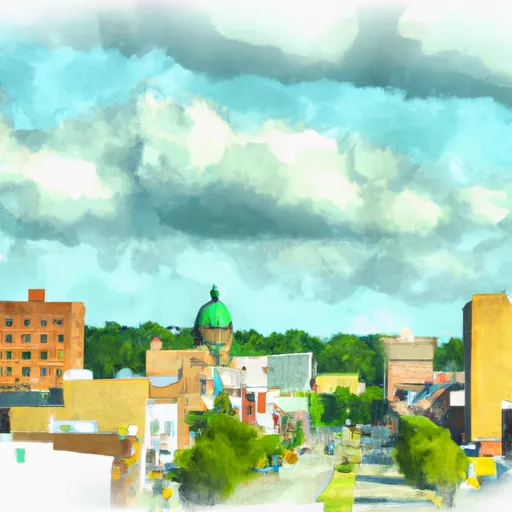-
 Snoflo Premium
Snoflo Premium
Get unlimited access to all our content
With no Ad interruptions! - Start Your Free Trial Login with existing account
Jamestown
Eden Index
Climate
8.0
•
Recreation
2.8
•
Community
1.1
•
Safeguard
4.5/10

Jamestown, Indiana is a small town located in Boone County. The climate in Jamestown is characterized by four distinct seasons. Summers are typically warm and humid, with temperatures ranging from the mid-70s to the low 90s Fahrenheit. Winters are cold with temperatures often dropping below freezing, and snowfall is common.
Hydrology constituents in Jamestown primarily revolve around Big Walnut Creek, a major waterway in the area. The creek offers various recreational activities such as fishing, canoeing, and kayaking. Outdoor enthusiasts can explore its serene waters and enjoy the surrounding scenic beauty.
Additionally, Jamestown is home to several parks and natural areas, providing ample opportunities for outdoor recreation. The town's largest park, W.R. Carson Park, offers amenities like picnic shelters, playgrounds, and sports fields. The nearby Northwest Hendricks County Park provides hiking trails, wildlife viewing, and fishing spots.
Overall, Jamestown presents a favorable climate for outdoor activities, with its diverse seasons and the presence of water bodies like Big Walnut Creek.
What is the Eden Index?
The Snoflo Eden Index serves as a comprehensive rating system for regions, evaluating their desirability through a holistic assessment of climate health, outdoor recreation opportunities, and natural disaster risk, acknowledging the profound impact of these factors on livability and well-being.
Climate Health Indicator (CHI): 8.0
Jamestown receives approximately
1067mm of rain per year,
with humidity levels near 83%
and air temperatures averaging around
11°C.
Jamestown has a plant hardyness factor of
5, meaning
plants and agriculture in this region thrive during a short period during spring and early summer. Most
plants will die off during the colder winter months.
By considering the ideal temperature range, reliable water supplies, clean air, and stable seasonal rain or snowpacks, the Climate Health Indicator (CHI) underscores the significance of a healthy climate as the foundation for quality living.
A healthy climate is paramount for ensuring a high quality of life and livability in a region, fostering both physical well-being and environmental harmony. This can be characterized by ideal temperatures, reliable access to water supplies, clean air, and consistent seasonal rain or snowpacks.
Weather Forecast
Streamflow Conditions
Wabash
Area Rivers
Wabash
Snowpack Depths
Wabash
Reservoir Storage Capacity
Wabash
Groundwater Levels
Recreational Opportunity Index (ROI): 2.8
The Recreational Opportunity Index (ROI) recognizes the value of outdoor recreational options, such as parks, hiking trails, camping sites, and fishing spots, while acknowledging that climate plays a pivotal role in ensuring the comfort and consistency of these experiences.
Access to outdoor recreational opportunities, encompassing activities such as parks, hiking, camping, and fishing, is crucial for overall well-being, and the climate plays a pivotal role in enabling and enhancing these experiences, ensuring that individuals can engage in nature-based activities comfortably and consistently.
Camping Areas
| Campground | Campsites | Reservations | Toilets | Showers | Elevation |
|---|---|---|---|---|---|
| Newton Stewart State Rec Area - Patoka Lake | 500 | 728 ft | |||
| Sycamore Springs Park | None | 490 ft | |||
| Spring Mill State Park | 220 | 670 ft | |||
| Springs Valley Rec Area | 10 | 672 ft | |||
| Paynetown State Rec Area - Monroe Lake | 320 | 557 ft | |||
| Martin State Forest | 25 | 743 ft | |||
| Cages Bend - Old Hickory Lake | 43 | 477 ft | |||
| Hardin Ridge | 200 | 780 ft | |||
| Ferdinand State Forest | 70 | 489 ft | |||
| Crane MWR Military | None | 594 ft |
Nearby Ski Areas
Catastrophe Safeguard Index (CSI):
The Catastrophe Safeguard Index (CSI) recognizes that natural disaster risk, encompassing floods, fires, hurricanes, and tornadoes, can drastically affect safety and the overall appeal of an area.
The level of natural disaster risk in a region significantly affects safety and the overall livability, with climate change amplifying these risks by potentially increasing the frequency and intensity of events like floods, fires, hurricanes, and tornadoes, thereby posing substantial challenges to community resilience and well-being.
Community Resilience Indicator (CRI): 1.1
The Community Resilience Indicator (CRI) recognizes that education, healthcare, and socioeconomics are crucial to the well-being of a region. The CRI acknowledges the profound impact of these elements on residents' overall quality of life. By evaluating educational resources, healthcare accessibility, and economic inclusivity, the index captures the essential aspects that contribute to a thriving community, fostering resident satisfaction, equity, and social cohesion.

